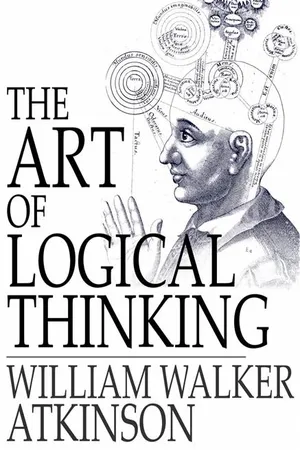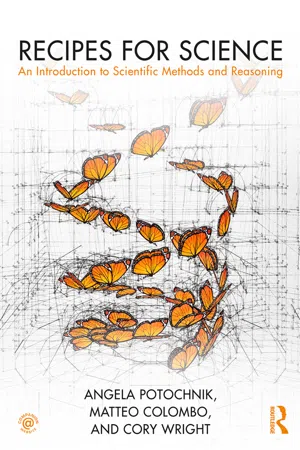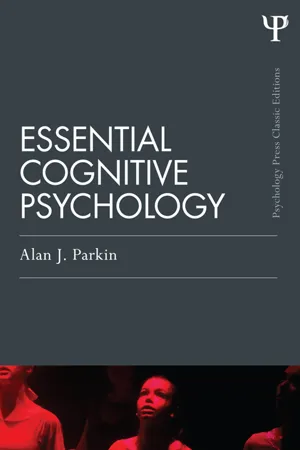Inductive Reasoning
Inductive reasoning in mathematics involves making generalizations based on specific observations or examples. It is a bottom-up approach where conclusions are drawn from specific instances to form a general principle or rule. While inductive reasoning can provide strong evidence, it does not guarantee the truth of the conclusion, making it important to test and verify the generalization.
8 Key excerpts on "Inductive Reasoning"
- eBook - ePub
Art of Logical Thinking
Or the Laws of Reasoning
- (Author)
- 2013(Publication Date)
- The Floating Press(Publisher)
...Chapter XI - Inductive Reasoning * Inductive Reasoning, as we have said, is the process of discovering general truth from particular truths, or inferring general laws from particular facts. Thus, from the experience of the individual and the race regarding the particular truth that each and every man under observation has been observed to die sooner or later, it is inferred that all men die, and hence, the induction of the general truth that "All men must die." Or, as from experience we know that the various kinds of metals expand when subjected to heat, we infer that all metals are subject to this law, and that consequently we may arrive by Inductive Reasoning at the conclusion that: "All metals expand when subjected to heat." It will be noticed that the conclusion arrived at in this way by Inductive Reasoning forms the fundamental premise in the process of Deductive Reasoning. As we have seen elsewhere, the two processes, Inductive and Deductive Reasoning, respectively are interdependent—resting upon one another. Jevons says of Inductive Reasoning: "In Deductive Reasoning we inquire how we may gather the truth contained in some propositions called Premises, and put into another proposition called the Conclusion. We have not yet undertaken to find out how we can learn what propositions really are true, but only what propositions are true when other ones are true. All the acts of reasoning yet considered would be called deductive because we deduce, or lead down the truth from premises to conclusion. It is an exceedingly important thing to understand deductive inference correctly, but it might seem to be still more important to understand inductive inference, by which we gather the truth of general propositions from facts observed as happening in the world around us." Halleck says: "Man has to find out through his own experience, or that of others, the major premises from which he argues or draws his conclusions...
- eBook - ePub
Mathematical Reasoning
Patterns, Problems, Conjectures, and Proofs
- Raymond Nickerson(Author)
- 2011(Publication Date)
- Psychology Press(Publisher)
...6 CHAPTER Informal Reasoning in Mathematics A mathematician’s work is mostly a tangle of guesswork, analogy, wishful thinking and frustration, and proof, far from being the core of discovery, is more often than not a way of making sure that our minds are not playing tricks. (Rota, 1981) The characterization of mathematics as a deductive discipline is accurate but incomplete. It represents the finished and polished consequences of the work of mathematicians, but it does not adequately represent the doing of mathematics. It describes theorem proofs but not theorem proving. Moreover, the history of mathematics is not the emotionless chronology of inventions of evermore esoteric formalisms that some people imagine it to be. It has its full share of color, mystery, and intrigue. That the process of mathematical discovery is not revealed in the finished proofs that mathematicians publish was pointed out by Evariste Galois, the brilliant French mathematician who, after inventing group theory, died in a duel at the age of 21. It has been convincingly documented by Polya (1954a, 1954b) and Lakatos (1976). In addition to deducing the implications of axioms, mathematicians also invent new axiomatic systems, and this cannot be done by deductive reasoning alone. As Polish-American mathematician Stanislav Ulam (1976) puts it, “In mathematics itself, all is not a question of rigor, but rather, at the start, of reasoned intuition and imagination, and, also, repeated guessing” (p. 154). Rucker (1982) makes essentially the same point: “In the initial stages of research, mathematicians do not seem to function like theorem-proving machines. Instead, they use some sort of mathematical intuition to ‘see’ the universe of mathematics and determine by a sort of empirical process what is true. This alone is not enough, of course. Once one has discovered a mathematical truth, one tries to find a proof for it” (p...
- eBook - ePub
- Harry Gensler(Author)
- 2002(Publication Date)
- Routledge(Publisher)
...Inductive Reasoning is a form of guessing based on recognizing and extending known patterns and resemblances. Let me sum up. A deductive argument claims that it’s logically necessary that if the premises are all true then so is the conclusion. An inductive argument claims that it’s likely (but not logically necessary) that if the premises are all true then so is the conclusion. While this book is mostly about deductive arguments, this chapter focuses on inductive ones. We can refine our AT conclusion by specifying a probability: 90 percent of the AT shelters have water. Rocky Gap is an AT shelter. This is all we know about the matter. ∴ It’s 90 percent probable that Rocky Gap has water. The general principle is this: Statistical Syllogism N percent of A’s are B’s. X is an A. This is all we know about the matter. ∴ It’s N percent probable that X is a B. Here’s another example: 50 percent of coin tosses are heads. This is a coin toss. This is all we know about the matter. ∴ It’s 50 percent probable that this is heads Suppose that all we know affecting the probability of the toss being heads is that 50 percent of coin tosses are heads and that this is a coin toss. Then it’s 50 percent probable to us that the toss is heads. This holds if we didn’t yet toss the coin, or if we tossed it but didn’t yet know how it landed. The matter is differ-ent if we know how it landed. Then it’s no longer just 50 percent probable to us that it’s heads; rather, we know that it’s heads or that it’s tails. Statistical syllogisms apply most cleanly if we know little about the subject. Suppose we know these two things about Michigan’s football team: It’s first down—and Michigan runs 70 percent of the time on first down. Michigan is behind—and passes 70 percent of the time when it’s behind. Relative to 1, Michigan probably will run. Relative to 2, Michigan probably will pass. But it’s unclear what Michigan probably will do relative to 1 and 2...
- eBook - ePub
- Mel Thompson(Author)
- 2012(Publication Date)
- Teach Yourself(Publisher)
...There are two very different forms of argument: A deductive argument starts with a general principle and deduces other things from it. So, for example, if you assume that all heavenly bodies must be perfect spheres, a logical deduction is that there cannot be mountains on the Moon. An inductive argument starts with observations or experimental results and on the basis of these sets about framing general principles that take them into account. Thus, observing mountains on the Moon, you conclude that not all heavenly bodies are perfect spheres. It was the inductive form of argument – generally termed ‘inductive inference’ – that became a distinguishing feature of modern science. Bertrand Russell described the ‘principle of induction’ by saying that the more two things are observed together, the more it is assumed that they are causally linked. If I perform an experiment only once, I may be uncertain of its results. If I perform it a hundred times, with the same result each time, I become convinced that I will obtain that result every time I perform it. Thus far, this sounds no more than common sense, but it raises many problems, for it is one thing to anticipate the likely outcome of an experiment on the basis of past experience, quite another to say that the past experience proves that a certain result will always be obtained, as we shall see later. The black swan There is a classic example of induction which makes the situation so clear that it is always worth repeating… Someone from Europe, having seen many swans, all of them white, comes to the conclusion that ‘all swans are white’ and anticipates that the next swan to appear will also be white. That generalization is confirmed with every new swan that is seen...
- eBook - ePub
Recipes for Science
An Introduction to Scientific Methods and Reasoning
- Angela Potochnik, Matteo Colombo, Cory Wright(Authors)
- 2018(Publication Date)
- Routledge(Publisher)
...Scientists typically have independent evidence for many of their auxiliary assumptions. Instruments and measurement procedures have been tested and employed in other circumstances, and background beliefs about a phenomenon are often based on evidence. These considerations can be used to help scientists decide whether, and when, to reject the hypothesis under investigation. Yet the need for auxiliary assumptions limits the power of the H-D method of hypothesis-testing. The Duhem-Quine problem makes clear that, just like confirmation, refutation is messier than simple deductive inference. Axiomatic Methods Deductive inference plays a different kind of role in some fields of science. Progress in scientific reasoning is sometimes achieved through formal axiomatization, a constructive procedure by which statements are derived from foundational principles. The foundational principles, called axioms, are accepted as self-evident truths about some domain. The axioms are then used to deductively infer other truths about the domain, called theorems. The most venerable example of axiomatization comes from the Greek mathematician Euclid, who lived between the 4th and 3rd centuries BCE. Book I of Euclid’s Elements of Geometry begins with 23 definitions and five axioms. The five axioms are the following: A straight line may be drawn between any two points. Any terminated straight line may be extended indefinitely. A circle may be drawn with any given point as center and any given radius. All right angles are equal. If two straight lines in a plane are met by another line, and if the sum of the internal angles on one side is less than two right angles, then the straight lines will meet if extended sufficiently on the side on which the sum of the angles is less than two right angles. Together, these five axioms form the premises of Euclidean geometry...
- eBook - ePub
- Harry J Gensler(Author)
- 2017(Publication Date)
- Routledge(Publisher)
...The premise claims that we have no such further information. Inductive arguments differ from deductive ones in two ways. (1) Inductive arguments vary in how strongly the premises support the conclusion; “99 percent of AT shelters have water” supports the conclusion more strongly than does “60 percent of AT shelters have water.” We have shades of gray here – not the black and white of deductive validity/invalidity. (2) Even a strong inductive argument has only a loose connection between premises and conclusion. The premises make the conclusion at most only highly probable; the premises might be true while the conclusion is false. Inductive Reasoning is a form of guessing based on recognizing and extending known patterns and resemblances. So a deductive argument claims that it’s logically necessary that if the premises are all true, then so is the conclusion. An inductive argument claims that it’s likely (but not logically necessary) that if the premises are all true, then so is the conclusion. This chapter focuses on inductive arguments. If we refine our conclusion to specify a numerical probability, we get the classic statistical syllogism form: Statistical Syllogism N percent of A’s are B’s. X is an A. That’s all we know about the matter. ∴ It’s N percent probable that X is a B. 90 percent of AT shelters have water. Rocky Gap is an AT shelter. That’s all we know about the matter. ∴ It’s 90 percent probable that Rocky Gap has water. Here’s another example: 50 percent of coin tosses are heads. This is a coin toss. That’s all we know about the matter. ∴ It’s 50 percent probable that this is heads. Suppose that all we know affecting the probability of the toss being heads is that 50 percent of coin tosses are heads and that this is a coin toss. Then it’s 50 percent probable to us that the toss is heads. This holds if we hadn’t yet tossed the coin, or if we tossed it but didn’t yet know how it landed. The matter is different if we know how it landed...
- eBook - ePub
- Alan J. Parkin(Author)
- 2013(Publication Date)
- Psychology Press(Publisher)
...43, 44, 45, 46, 47, 48, 49. It is unlikely, however, that any of you would do this because you believe, wrongly, that a consecutive sequence could not arise by chance. In fact, the above sequence is just as likely as any other sequence because the selection of one number does not influence what other numbers appear. In this chapter we will see that many important insights about human reasoning arise from observing the reasoning errors that people make. Induction versus deduction An essential distinction in reasoning is that between inductive and deductive reasoning. In Inductive Reasoning we attempt to derive more general conclusions from available facts, e.g. ‘Jim seems a nice man, I expect he enjoys his job’. In deductive reasoning we derive a specific fact from a general set of facts, e.g. ‘Hay fever causes people misery in the summer. Alan has hay fever, therefore he is miserable in the summer’. While people can understand the process of deduction, it is abundantly clear that they do not do this reliably in the real world. In the lottery example above, deductive reasoning would lead us to conclude that the consecutive number sequence is as likely as any other. The fact that people do not accept this suggests that they are making their judgement on some other basis. It may be that people rely on their memory for winning sequences and recall that a consecutive sequence has never been drawn. However, millions of other non-consecutive sequences have never been drawn either and the inference that consecutive sequences are special is false. Availability heuristics While some situations do present all the available facts and thus allow deductive reasoning, many others do not, and the human being must rely on induction to guide decisions. One obvious source of information about what decision to make is to reflect on what has happened before. Consider a friend, Chris, who advises you that shares in a particular company are likely to rise sharply in price...
- eBook - ePub
- Alan J. Parkin(Author)
- 2014(Publication Date)
- Psychology Press(Publisher)
...43, 44, 45, 46, 47, 48, 49. It is unlikely, however, that any of you would do this because you believe, wrongly, that a consecutive sequence could not arise by chance. In fact, the above sequence is just as likely as any other sequence because the selection of one number does not influence what other numbers appear. In this chapter we will see that many important insights about human reasoning arise from observing the reasoning errors that people make. Induction versus deduction An essential distinction in reasoning is that between inductive and deductive reasoning. In Inductive Reasoning we attempt to derive more general conclusions from available facts, e.g. “Jim seems a nice man, I expect he enjoys his job”. In deductive reasoning we derive a specific fact from a general set of facts, e.g. “Hay fever causes people misery in the summer. Alan has hay fever, therefore he is miserable in the summer”. While people can understand the process of deduction, it is abundantly clear that they do not do this reliably in the real world. In the lottery example above, deductive reasoning would lead us to conclude that the consecutive number sequence is as likely as any other. The fact that people do not accept this suggests that they are making their judgement on some other basis. It may be that people rely on their memory for winning sequences and recall that a consecutive sequence has never been drawn. However, millions of other non-consecutive sequences have never been drawn either and the inference that consecutive sequences are special is false. Availability heuristics An example of a heuristic to aid problem solving. While some situations do present all the available facts and thus allow deductive reasoning, many others do not, and the human being must rely on induction to guide decisions. One obvious source of information about what decision to make is to reflect on what has happened before...







